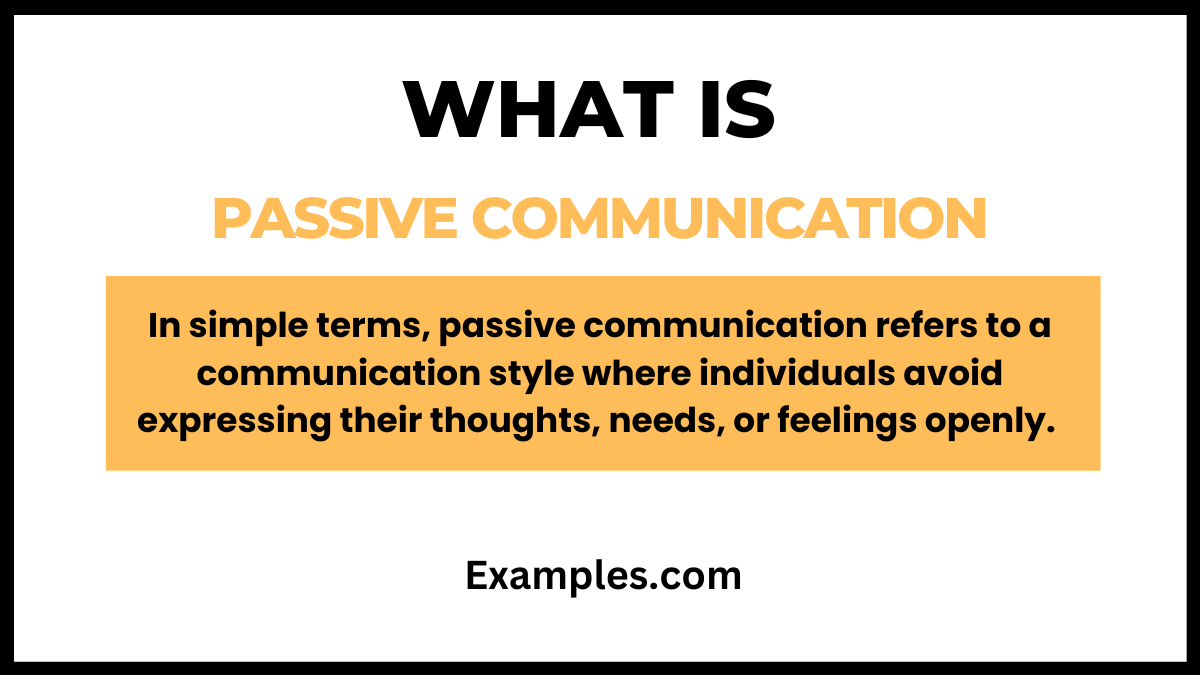How to Deal with Passive Communication?
Embarking on a transformative journey, our comprehensive guide on How to Deal with Passive Communication unravels the intricacies of handling subtle communication challenges. Navigate through insightful tips, actionable examples, and proven strategies to foster assertiveness. Discover how to turn passive interactions into assertive ones, empowering you to communicate effectively in diverse situations. This guide is your key to unlocking assertive communication skills, with real-world Communication Examples that bridge theory and practice.
How to Deal with Passive Communication? – Definition

In simple terms, passive communication refers to a communication style where individuals avoid expressing their thoughts, needs, or feelings openly. It often involves downplaying oneself, yielding to others excessively, and may lead to unmet personal or professional needs. This guide explores strategies for effectively addressing passive communication, providing insights into fostering assertiveness and building healthier communication dynamics. Understanding the definition of passive communication is the first step toward cultivating more effective and assertive interpersonal interactions.
How Do You Handle Passive Communication?
Handling passive communication requires a thoughtful and assertive approach to foster open dialogue. Here’s a comprehensive guide on effectively dealing with passive communication

- Identify Passive Cues: Begin by recognizing subtle signs of passivity, such as avoiding eye contact, hesitating, or using minimizing language. Identifying these cues helps you address passive behaviour proactively.
- Active Listening: Actively listen to the passive communicator. Understand their perspective, acknowledge their feelings, and demonstrate genuine interest. This creates a foundation for open communication.
- Ask Open-ended Questions: Encourage the passive individual to share more by asking open-ended questions. This helps them express themselves without feeling pressured, fostering a more assertive exchange.
- Express Empathy: Demonstrate empathy by acknowledging the passive communicator’s feelings. Let them know you understand their perspective, creating a supportive environment for open conversation.
- Use “I” Statements: Model assertive communication by using “I” statements to express your thoughts and feelings. This helps set a positive tone and encourages the passive individual to do the same.
- Provide Reassurance: Reassure the passive communicator that their opinions and needs are valued. Creating a safe space encourages them to share more openly without fear of judgment.
- Encourage Self-expression: Empower the individual to express themselves freely. Encourage them to share their thoughts, opinions, and concerns, fostering a culture of open communication.
- Offer Constructive Feedback: Provide feedback that highlights specific instances of passive communication. Focus on constructive suggestions for improvement rather than criticism.
- Set Clear Expectations: Establish clear expectations for communication within the relationship or team. This clarity helps mitigate passive behaviour by creating a framework for assertive interactions.
- Seek Collaboration: Collaborate with the passive communicator on finding solutions or addressing issues. Involving them in the decision-making process fosters a sense of empowerment.
How Do You Overcome Passive Behaviour?
Overcoming passive behaviour is a gradual process that involves self-awareness and intentional efforts. Here’s a guide to help individuals move beyond passive communication tendencies:
- Self-Reflection: Encourage self-reflection to identify instances of passive behaviour. Understanding the root causes is crucial for initiating positive change.
- Clarify Personal Values: Clarify personal values and beliefs. Recognize the importance of expressing oneself authentically and aligning communication with individual principles.
- Set Personal Goals: Establish goals for becoming more assertive. Break these goals into achievable steps, creating a roadmap for overcoming passive behaviour.
- Practice Assertive Communication: Actively practice assertive communication in various scenarios. Start with low-stakes situations and gradually progress to more challenging interactions.
- Role-Playing Exercises: Engage in role-playing exercises to simulate real-life scenarios. This provides a safe environment to practice assertiveness and receive constructive feedback.
- Build Confidence: Work on building self-confidence through positive affirmations, acknowledging achievements, and focusing on personal strengths.
- Communication Workshops: Attend communication workshops or seek professional guidance. These resources offer tools and strategies for overcoming passive behaviour.
- Establish Support Systems: Surround yourself with supportive individuals who encourage assertive communication. Share your goals with friends or colleagues who can provide constructive feedback.
- Mindfulness Practices: Embrace mindfulness practices to stay present in conversations. Mindfulness helps individuals become more aware of their communication tendencies and make intentional choices.
- Celebrate Progress: Celebrate small victories along the way. Overcoming passive behaviour is a continuous journey, and acknowledging progress reinforces positive communication habits.
What Are the Causes of Passive Communication?
Understanding the root causes of passive communication is crucial for addressing and overcoming this behaviour. Several factors contribute to individuals adopting a passive communication style:
- Fear of Confrontation: People may fear conflict or confrontation, leading them to avoid expressing their opinions or needs to prevent potential disagreements.
- Low Self-Esteem: Individuals with low self-esteem may doubt the validity of their thoughts and feelings, making them hesitant to assert themselves in communication.
- Cultural Background: Cultural norms and upbringing can influence communication styles. Some cultures may emphasize politeness and avoiding direct confrontation.
- Past Negative Experiences: Previous negative experiences, such as criticism or rejection, can shape passive communication as individuals try to protect themselves from potential harm.
- Lack of Assertiveness Skills: The absence of assertiveness skills may lead to passive communication. Individuals may not know how to express themselves confidently without being overly submissive or aggressive.
- Desire for Approval: Seeking approval from others can drive passive communication. Individuals may prioritize being liked over expressing their true thoughts or feelings.
- Communication Barriers: Issues like language barriers or difficulty expressing oneself effectively can contribute to passive communication.
Why Is Passive Communication a Problem?
Passive communication poses several challenges, affecting both individuals and relationships. Recognizing why passive communication is problematic is essential for promoting healthier communication dynamics:
- Unmet Needs: Passive communicators often struggle to express their needs, leading to unmet personal and professional requirements.
- Misunderstandings: Lack of clarity in passive communication can result in misunderstandings, as others may not grasp the intended message or needs.
- Build-up of Resentment: Suppressing thoughts and feelings can lead to the buildup of resentment over time, potentially damaging relationships.
- Stifled Personal Growth: Individuals practicing passive communication may hinder their personal growth by avoiding challenges or opportunities for assertiveness.
- Ineffective Problem-Solving: Passive communication can hinder effective problem-solving, as individuals may not contribute ideas or voice concerns openly.
- Impact on Mental Health: Consistently suppressing thoughts and feelings can contribute to stress, anxiety, and a negative impact on mental health.
- Strained Relationships: Passive communication can strain relationships, as others may perceive the individual as indecisive, disengaged, or uninterested.
- Reduced Productivity: In professional settings, passive communication may hinder collaboration and reduce overall productivity.
In the comprehensive guide on “How to Deal with Passive Communication,” various strategies for handling passive communication styles and fostering assertiveness are discussed. This involves recognizing passive cues, practicing active listening, asking open-ended questions, expressing empathy, using “I” statements, providing reassurance, encouraging self-expression, offering constructive feedback, setting clear expectations, and seeking collaboration. These tactics aim to transform passive interactions into more assertive, effective communication??.
Passive communication, characterized by avoiding stating one’s thoughts and feelings, often leads to unmet personal or professional needs. It includes patterns of submissive attitudes, people-pleasing tendencies, and deferring to others’ preferences to avoid conflict, discomfort, or guilt. To improve passive communication, it’s recommended to practice assertiveness in easy situations, learn to say no, self-monitor during conversations, notice feelings, give oneself a second chance, ask for clarification, speak clearly, practice body language, and be mindful of nonverbal cues. These steps can help individuals become more self-aware and empowered in their decisions and life??.
To further explore techniques for dealing with passive communication and fostering assertiveness, the following resources provide valuable insights and strategies:
- Choosing Therapy offers a detailed guide on “Passive Communication: Definition, Examples, & How to Handle It.” This resource provides a comprehensive understanding of passive communication and practical ways to improve this communication style. Visit their website at Choosing Therapy.
- Talent Transformation provides useful tips on “How to Communicate When People Are Passive or Aggressive.” This guide focuses on strategies for effectively communicating with passive individuals. Access their insights at Talent Transformation.



